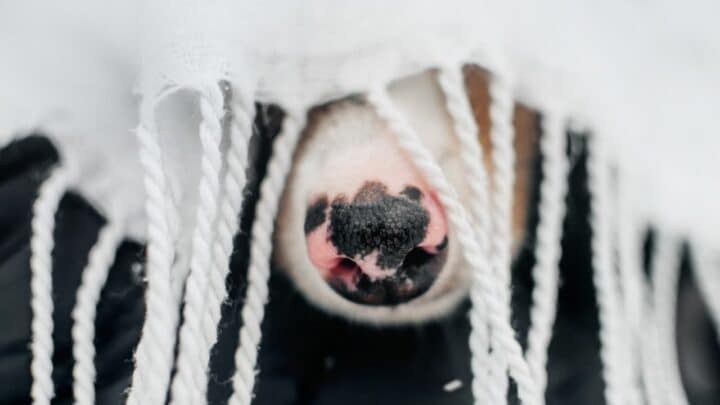Although it is doubtful that a prospective dog owner would select a pup completely based on the color of their nose, many people may find it to be interesting that some dogs have a pink nose rather than the standard black nose.
This may pique a person’s curiosity and leave them with several unanswered questions.
Why is it that some dogs develop pink noses? What dog breeds commonly have pink noses?
Fortunately, you no longer have to be baffled by the phenomenon of pink-nosed dogs.
The answers are much less complicated than you may think.
What Dog Breeds Have Pink Noses?
Dog breeds that maintain a pink-colored nose throughout the course of their lives include Irish Setters, Field, Cocker Spaniels, Pointers, Dalmatians, English Springers, Siberian Huskies, Nova Scotias, and Australian Shepherds. Occasionally, Boxers, American Pitt Bull Terriers, Heelers, and some Labradors may keep their pink noses through adulthood.
Dogs That Maintain a Pink Nose throughout Their Lives
Most dogs are born with pink noses, but the color darkens as they age and their levels of melatonin build.
However, some breeds naturally have lower levels of melatonin, which is the hormone that determines coloring.
This is not a strange occurrence as the same is true of humans that have blond hair and blue eyes. This phenomenon’s just a matter of having recessive genetic traits at birth.
Pink-nosed dogs are said to have what is known as the liver gene, which is a less common genetic marker that occurs primarily in certain dog breeds.
Although you cannot determine temperament or behavior by nose color alone, genetics does indeed influence animal behavior.
Mainly, the liver gene does nothing more than determining a dog’s appearance and coloring and has little to do with reflecting temperament.
Dogs with the liver gene usually have lighter-colored coats, pink noses, and eyes that are an amber shade.
While dogs without this gene will eventually develop dark-colored noses, liver gene dogs continue to have a pink nose as they grow older, and their nose will remain that shade throughout their lifetime.
Dogs That Have Seasonally Pink Noses
You may have owned or encountered a dog whose nose changed color every winter.
This is often referred to as a snow nose, and it doesn’t mean that the dog necessarily carries the liver gene at all.
On the contrary, dogs that develop a snow nose usually have a regular black-colored nose throughout the warmer months of the year, but when winter rolls around, they become pink-nosed dogs.
Although certain breeds such as Retrievers, Bernese mountain dogs, and Siberian Huskies are known to be more susceptible to developing a seasonal pink nose, this phenomenon has more to do with the environment than it does genetics.
It’s believed that reduced sunlight exposure and the drop in temperature are responsible for the development of snow noses.
Dogs That Develop Pink Noses Due To Age or Environmental Factors
There is a third scenario that explains the mystery behind certain pink-nosed dogs that involve a combination of genetics, age, and environmental influences.
This phenomenon’s known as a Dudley nose.
While there is some overlap between dogs with the liver gene and dogs that are more prone to developing a Dudley nose, this phenomenon is not only influenced by genetics, but may also be caused by age, illness, and excessive sun exposure.
Dudley noses are originally darker colored but eventually fade into a blotchy pink tone that continues to expand throughout the entire nose.
Just as humans often develop white or grey hair as they age due to a decrease in melatonin production, certain dog breeds lose the coloration of their noses as they age.
Allergies, sunburn, injuries, and bacterial infections can also result in the development of a Dudley nose.
Dogs that carry the liver gene are naturally more susceptible to the development of a Dudley nose in the event that their nose doesn’t remain pink throughout their entire life, as is the case with American Pitt Bull Terriers, Pointers, and Irish Setters.
However, some dogs that aren’t known to carry the liver gene remain prone to developing a Dudley nose, such as Doberman Pinschers, Golden Retrievers, German Shepherds, and Poodles.
Frequently Asked Questions About What Dog Breeds Have Pink Noses
Do Dogs With Pink Noses Turn Black?
The majority of puppies that are born with pink noses eventually develop a standard black nose by the time they reach sixteen weeks old. However, in cases where the puppy carries the liver gene, they may continue to have a pink nose throughout the course of their life.
Can I stop my Canine’s Nose from Going Pink?
Believe it or not, it’s claimed that eating and drinking from plastic bowls can influence the color of a dog’s nose. You can test this theory by switching to a metal or ceramic bowl and see if that makes a difference. Otherwise, you can apply sunblock to your dog’s nose to reduce the impact of UV rays or make a veterinary appointment to rule out illness or allergies. However, if your dog’s nose is turning color due to age, unfortunately, there’s nothing you can do.
What Does A Pink Nose In Dogs Mean?
As stated above, it usually means that your dog carries the recessive liver gene. In some instances, it may be a seasonal change or a response to aging or environmental influences.
Conclusion
There are several dog breeds that have pink noses throughout their lifetime due to genetics.
Additionally, there are a few breeds that are prone to developing pink noses during the winter months or as they age.
Although pink-nosed dogs are rarer, this characteristic has nothing to do with their temperament or personality.
It simply adds to a dog’s uniqueness and individuality.


